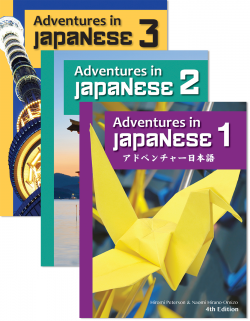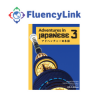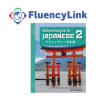Explore the rich world of Japanese language and culture with the perenially best-selling textbook series Adventures in Japanese, now updated in the 4th Edition for today's classrooms. The three-volume series gives novice students a strong command of Japanese through targeted emphasis on the four language skills, while sustaining their interest with full-color manga dialogues and fun activities and projects.
With dialogues that follow a cast of American high school students as they learn Japanese, the lessons in all three volumes draw from topics that are appealing and relevant to teenagers. Volumes 1 & 2 deal with different themes of daily life, such as school, shopping, family, and hobbies, while Volume 3 has a more global and socially minded focus.
A rich variety of communicative activities gauge students’ comprehension and allow them to apply new skills immediately. Pair and group activities encourage interpersonal communication, and authentic reading exercises are presented in real-life, relevant contexts. Activities are aligned with the ACTFL World-Readiness Standards (5Cs), Common Core, and 21st Century Skills. Extensive hiragana, katakana, and kanji practice early on ensures students know how to write correctly using all three Japanese writing systems.
Culture Notes sprinkled throughout the texbook provide insights into the nuances of contemporary Japanese culture. At the end of each lesson, there is also a review section along with either a Project Corner, which could have students making origami or cooking Japanese rice cakes, or a Japanese Culture section that encourages students to research topics like Japanese New Year or the cost of living in Japan, keeping classroom instruction lively and fun.
The student resources hosted on the companion website include textbook and workbook audio, flashcards, vocabulary lists, and additional review lessons and project corners. The teacher resources include audio for the tests, professional development materials, additional activities, and scope and sequence and correlations.
In this Series
Volume 3
Volume 2
Volume 1
What’s new in the 4th Edition?
- Full-Color Textbook Design The full-color design of the 4th Edition is easier to read and easier to navigate. More photos bring Japanese culture to life. Updated vocabulary reflects changes in technology and in Japanese society.
- More Practice Grammar exercises have been added after each grammar explanation in the textbook. Authentic materials provide students with real-world reading practice.
- Improved Pacing Now with 12 lessons instead of 16, pacing and instructional flow have been streamlined, making Adventures in Japanese easier to complete in one year.
- Clear Expectations Can-Do statements and self-assessment checklists have been added to each lesson so objectives and expectations are clearly defined. Review Lessons are available for download on the companion website.
- More Kanji More than 60 kanji are introduced in Volume 1 to provide students with a stronger foundation for continued study and AP® exam preparation.
- Audio New audio recordings for Dialogues, Vocabulary, Language in Context, Grammar models, review questions, audio activities, and Culture Notes are available for download from the companion website.
- Common Core Activities Additional activities aligned with the Common Core State Standards (CCSS) for English Language Arts are included throughout the textbook. Accompanying the Culture Notes, these activities encourage students to read critically and write narrative, informational, and persuasive responses.
- 21st Century Skills Activities Students extend their learning about cultural topics by using technology to do research, create presentations, and improve their language skills and cultural competence.
- Connect Activities Students use Japanese to practice skills in other career-based disciplines, including math, statistics, science, and social studies.
- Recycling Recycling of key grammar structures and vocabulary is now clearly indicated.
- Digital Teacher's Guide to Go Access all of the Adventures in Japanese teacher materials on a convenient USB flash drive. Easy to carry, easy to use, and easy to customize.
"We like the grammar instruction and cultural notes. Easy steps. Easy to understand. Easy to teach. Nice to have beautiful photos. Students enjoy looking at them. My students and I especially love the kanji with pictures. The pictures make it much easier and more fun for students to learn kanji."
"I have taught Japanese nearly 20 years, but the Adventures in Japanese series is the best...The textbooks, worksheets, quizzes and tests, and USB availability really help teachers to focus on teaching, not spending time producing supplements, quizzes and exams. Also, new vocabulary shows up in the next lessons, so students can concentrate on other sets of vocabulary and sentence structures."
"We love the Adventures in Japanese 4th Edition series. The constant reinforcement of grammar and vocabulary is particularly appreciated among the students. They also love the anime scripts at the beginning and throughout the text. Adventures in Japanese, for us, is a very cohesive work and makes it fun to study."
"Students really responded to the full color manga dialogues. My school district loved seeing a Japanese textbook in hard cover. I really appreciated how the exercises and activities contributed to my students' communicative competence. The 4th Edition really does have something for everyone!"
"We use AIJ levels 1 to 3 for all of our Japanese courses. We highly recommend the AIJ series as it maximizes our students' learning of Japanese language and culture. The AIJ series covers the topics and concepts of IB and AP very well. The series also conveys the important message of being a peace builder and responsible global citizen. Lots of authentic resources and culture notes help students connect with real life situations. The Workbook exercises add a degree of difficulty that tests deeper understanding of the material. The speakers in the listening exercises speak according to the level, which helps students become accustomed to understanding Japanese speaking. There is sufficient support material for both teachers and students to reinforce skills and knowledge."















